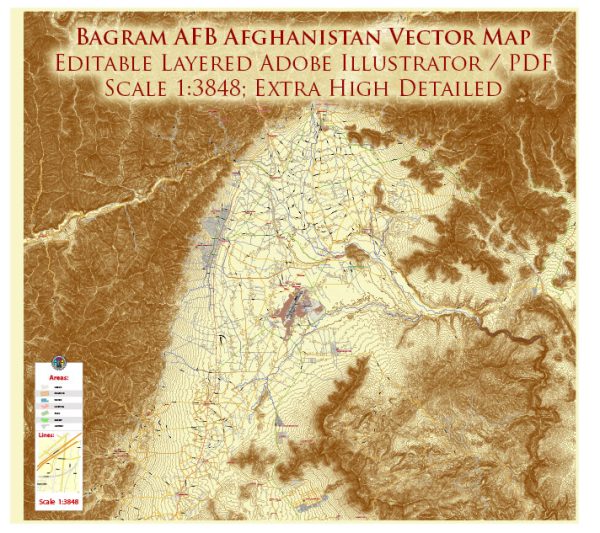Bagram Air Force Base (BAFB) in Afghanistan has primarily served as a military installation rather than an economic center. Its economic history is closely tied to the broader geopolitical and military developments in the region. BAFB has been a key hub for the United States and its allies during the War in Afghanistan, which began in 2001 following the 9/11 attacks.
Vectormap.Net provide you with the most accurate and up-to-date vector maps in Adobe Illustrator, PDF and other formats, designed for editing and printing. Please read the vector map descriptions carefully.
Here is an overview of the economic aspects related to Bagram Air Force Base:
- Construction and Development:
- Bagram Air Force Base underwent significant expansion and development since the early 2000s. The initial construction and development efforts were funded by the United States and its coalition partners.
- Contracting and Local Economy:
- The construction and maintenance of BAFB involved a considerable amount of contracting work, providing economic opportunities for local Afghan businesses and workers. Many local contractors were hired to provide services ranging from construction to logistics.
- Infrastructure Projects:
- The base’s presence has indirectly contributed to some infrastructure development in the surrounding areas. For instance, roads and other transportation infrastructure were improved to facilitate the movement of goods and personnel to and from the base.
- Employment Opportunities:
- BAFB created job opportunities for local Afghans in various capacities, including as laborers, translators, and support staff. However, the economic impact on the local population was not uniform, and the extent of positive economic spillover varied.
- Impact on Local Markets:
- The influx of military personnel and contractors at BAFB created a demand for goods and services in the local markets. This had both positive and negative effects, as it increased economic activity for some businesses while also causing inflation and market distortions.
- Security and Economic Challenges:
- The security situation in Afghanistan, particularly in the regions surrounding Bagram, posed challenges to sustained economic development. Ongoing conflict, insurgency, and political instability in the country hindered long-term economic growth and stability.
- Transition and Closure:
- The economic dynamics around BAFB underwent changes as the U.S. and NATO forces began to withdraw from Afghanistan. The closure of the base in July 2021 marked a significant shift, and its impact on the local economy depended on how well the transition was managed.
It’s important to note that Bagram Air Force Base’s economic history is intertwined with the broader context of the War in Afghanistan, and its closure reflects geopolitical decisions rather than economic factors alone. The base’s closure had complex implications for both the military strategy in the region and the local economy.


 Author: Kirill Shrayber, Ph.D.
Author: Kirill Shrayber, Ph.D.